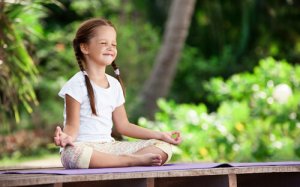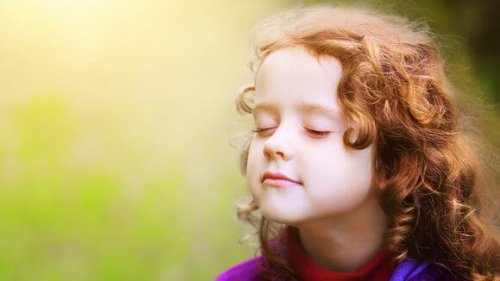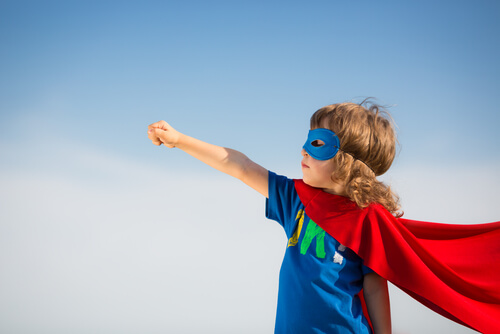Mindfulness for Kids - Learning to Manage Emotions


Written and verified by the psychologist Sergio De Dios González
Mindfulness for kids opens up a world of possibilities to help children be healthy and happy. It can improve attention and train their brains in empathy, tranquility, and emotional management.
Also, getting our little ones started in the world of meditation makes it easier for them to get in touch with themselves. The idea is that they can more readily adapt to any situation, especially those they deal with every day.
We know that mindfulness during our complex, adult day-to-day lives has many benefits. The things we have to deal with – on a professional and personal level – make their mark on us.
They add stress and anxiety to our lives. To deal with this, meditation and mindfulness strategies are helpful, cathartic, and effective.
Let’s offer a safe space to our children. A space free of stress and anxiety. Let’s use mindfulness to teach them where their center is. Let’s help them reach a calm space where they can better understand their emotions.
Since mindfulness and other techniques are so useful for adults, why don’t we teach them to children? Interestingly, there are already many schools all over the world that include this practice in the classroom.
They include breathing, meditation, and mindfulness exercises in the daily routine. These help the children achieve their developmental milestones more easily.
However, it is important that we establish these types of exercises from an early age. We all know, for example, how hard it could be to do relaxation exercises with middle schoolers for the first time.
In schools that incorporate mindfulness, however, children as young as 3 and 4 see it as normal. They are used to spending time in silence or concentrating on their own breathing. In that sense, they have a headstart and can advance more quickly in developing other abilities.
Let’s see how and in what way we can help children get started in this extensive and highly beneficial practice…

Mindfulness for kids – benefits and challenges
Many countries with well-developed education systems recognize the benefits of mindfulness for kids. The UK, Canada, Holland, the United States, and Australia all plan to include it in the general curriculum.
By 2020, mindfulness practice should be in every school. At the moment, they are introducing it progressively to very young children. The goal is to take advantage of young children’s receptive brains.
If you are wondering what is the best age to start to incorporate mindfulness, we have to stress one small detail. It is ideal to start at around 3 years old.
However, if we want to get results, we have to be consistent so that it becomes a habit. Then, it will keep itself going. Let’s take a closer look at this idea.
I’m interested in the world around me
The main objective of mindfulness for kids is to awaken their curiosity and attention. We don’t want their capacity for amazement to ever fade.
The same goes for their interest in connecting with the outer world from their receptive, relaxed, and confidence inner selves.
I am more aware of my surroundings
Likewise, the ability to better focus their attention on specific things enhances concentration. This is key in our overstimulated world. Small children don’t have stable or reasonable filters to manage this sensory onslaught.
I understand, I control, and I channel negative emotions
On the other hand, just as we mentioned earlier, mindfulness is more than a series of exercises to adopt as a way of life. Its techniques, philosophy, and focus can provoke changes in us that can change our perspective.
Kids, for their part, will be able to better manage their negative emotions from an early age. They will understand where their anger or sadness comes from.
As a result, they will be able to channel it in the right way. That, in turn, will improve their social skills and the way they relate to other people. Consequently, they will be able to avoid violent and aggressive situations in the classroom.

“Mindfulness is a tool to help our children acquire more humanity. To help them become not just workers and consumers, but to cultivate from an early age the ability to be present in the world and be aware of how beautiful and fragile it is. “The child is the father of the man,” wrote the English poet Wordsworth. Personally, I am convinced (at the moment I don’t have proof or studies to show you) that mindfulness can help our children to become better adults.”
-Christophe André, psychiatric doctor at the Hospital Sainte-Anne in Paris-
Mindfulness for kids – fun and useful strategies to get them started
There is something important we should clarify before we begin. Mindfulness for kids isn’t limited to teaching them how to meditate, relax, and breathe.
It goes much deeper than that. We can’t forget that mindfulness is also related to diet, work, relationships, even sports!
Let’s see what kind of strategies we can develop to integrate this philosophy into children’s lives. There are two requirements – that it bis fun and simple. Here are some of the strategies that we can use with children between the ages of 3 and 6.
I am Superman or Wonder Woman
- Start by telling the children that they should stand in a “power” pose as if they were superheroes. They should be standing, with their back straight, hands on their hips and, most importantly, with their eyes closed.
- They are going to turn into superheroes who have super senses!
- In strict silence, they will listen to all the sounds around them for 5 minutes. They must be super alert and relaxed so they can turn on their radars to all sounds, as tiny as they might be…

I learn to breathe with my stuffed animal
There’s nothing better than a stuffed animal to teach breathing. Follow these instructions.
- Naptime is always a perfect moment to teach them relaxed breathing.
- Tell the children to put their stuffed animal or doll on their belly.
- Then, tell them to inhale through their noses for 4 counts, They should watch how their belly rises and with it, their stuffed animal.
- They should hold their breath for 3 seconds and then exhale through the mouth. Tell them to notice how their stuffed animal sinks down again.
The weather and my emotions
Sitting Still Like a Frog is a wonderful book by Eline Snel. She offers interesting strategies for parents to meditate with their kids.
The author offers an interesting strategy to help kids recognize their emotions. She recommends teaching them to relate their emotions (like sadness, anger, or joy) with the weather.
- To do this, we tell them they are going to play the Weatherman game.
- They have to close their eyes and ask themselves “what is the weather like inside me today?” If it’s sunny, I am fine, if it’s raining, I am sad. If I am a storm with lightning, it’s because I am angry.
The “let’s notice” walk
Mindfulness for kids doesn’t only happen when they are sitting. Our little ones are active and reactive. They are eager for experiences and insatiably curious.
They need physical contact, games, and continuous interaction. So we have to adapt mindfulness to their daily needs and rhythm.
A very effective exercise that we can do with them every day is the “let’s notice” walk. After school, or when you are out and about, encourage them to notice their surroundings. You can say things like “I realize that…,” “I see that…,” “I discover that…”
The point is to encourage them to be open to their surroundings, no matter how small or insignificant they might seem.
“I notice that I can hear someone laughing far away,” “I noticed that that man looked sad,” “I realize that I can hear a baby bird in its nest cry for its mother,” “I notice that a cloud is blocking the sun…”
In conclusion, we know that there are many, many more mindfulness exercises that we can teach to our children. Find the ones that work best for their personality and age.
Likewise, don’t forget that we have to be good examples for them of tranquility, balance, and enduring affection.
“In today’s rush we all think too much, seek too much, want too much and forget about the joy of just Being.”
-Eckhart Tolle-
References
Snel, Eline (2013). Tranquilos y atentos como una rana. Madrid: Kairós.
Vara de Rey, P. .Mindfulness para niños. Barcelona: Planeta.
Mindfulness for kids opens up a world of possibilities to help children be healthy and happy. It can improve attention and train their brains in empathy, tranquility, and emotional management.
Also, getting our little ones started in the world of meditation makes it easier for them to get in touch with themselves. The idea is that they can more readily adapt to any situation, especially those they deal with every day.
We know that mindfulness during our complex, adult day-to-day lives has many benefits. The things we have to deal with – on a professional and personal level – make their mark on us.
They add stress and anxiety to our lives. To deal with this, meditation and mindfulness strategies are helpful, cathartic, and effective.
Let’s offer a safe space to our children. A space free of stress and anxiety. Let’s use mindfulness to teach them where their center is. Let’s help them reach a calm space where they can better understand their emotions.
Since mindfulness and other techniques are so useful for adults, why don’t we teach them to children? Interestingly, there are already many schools all over the world that include this practice in the classroom.
They include breathing, meditation, and mindfulness exercises in the daily routine. These help the children achieve their developmental milestones more easily.
However, it is important that we establish these types of exercises from an early age. We all know, for example, how hard it could be to do relaxation exercises with middle schoolers for the first time.
In schools that incorporate mindfulness, however, children as young as 3 and 4 see it as normal. They are used to spending time in silence or concentrating on their own breathing. In that sense, they have a headstart and can advance more quickly in developing other abilities.
Let’s see how and in what way we can help children get started in this extensive and highly beneficial practice…

Mindfulness for kids – benefits and challenges
Many countries with well-developed education systems recognize the benefits of mindfulness for kids. The UK, Canada, Holland, the United States, and Australia all plan to include it in the general curriculum.
By 2020, mindfulness practice should be in every school. At the moment, they are introducing it progressively to very young children. The goal is to take advantage of young children’s receptive brains.
If you are wondering what is the best age to start to incorporate mindfulness, we have to stress one small detail. It is ideal to start at around 3 years old.
However, if we want to get results, we have to be consistent so that it becomes a habit. Then, it will keep itself going. Let’s take a closer look at this idea.
I’m interested in the world around me
The main objective of mindfulness for kids is to awaken their curiosity and attention. We don’t want their capacity for amazement to ever fade.
The same goes for their interest in connecting with the outer world from their receptive, relaxed, and confidence inner selves.
I am more aware of my surroundings
Likewise, the ability to better focus their attention on specific things enhances concentration. This is key in our overstimulated world. Small children don’t have stable or reasonable filters to manage this sensory onslaught.
I understand, I control, and I channel negative emotions
On the other hand, just as we mentioned earlier, mindfulness is more than a series of exercises to adopt as a way of life. Its techniques, philosophy, and focus can provoke changes in us that can change our perspective.
Kids, for their part, will be able to better manage their negative emotions from an early age. They will understand where their anger or sadness comes from.
As a result, they will be able to channel it in the right way. That, in turn, will improve their social skills and the way they relate to other people. Consequently, they will be able to avoid violent and aggressive situations in the classroom.

“Mindfulness is a tool to help our children acquire more humanity. To help them become not just workers and consumers, but to cultivate from an early age the ability to be present in the world and be aware of how beautiful and fragile it is. “The child is the father of the man,” wrote the English poet Wordsworth. Personally, I am convinced (at the moment I don’t have proof or studies to show you) that mindfulness can help our children to become better adults.”
-Christophe André, psychiatric doctor at the Hospital Sainte-Anne in Paris-
Mindfulness for kids – fun and useful strategies to get them started
There is something important we should clarify before we begin. Mindfulness for kids isn’t limited to teaching them how to meditate, relax, and breathe.
It goes much deeper than that. We can’t forget that mindfulness is also related to diet, work, relationships, even sports!
Let’s see what kind of strategies we can develop to integrate this philosophy into children’s lives. There are two requirements – that it bis fun and simple. Here are some of the strategies that we can use with children between the ages of 3 and 6.
I am Superman or Wonder Woman
- Start by telling the children that they should stand in a “power” pose as if they were superheroes. They should be standing, with their back straight, hands on their hips and, most importantly, with their eyes closed.
- They are going to turn into superheroes who have super senses!
- In strict silence, they will listen to all the sounds around them for 5 minutes. They must be super alert and relaxed so they can turn on their radars to all sounds, as tiny as they might be…

I learn to breathe with my stuffed animal
There’s nothing better than a stuffed animal to teach breathing. Follow these instructions.
- Naptime is always a perfect moment to teach them relaxed breathing.
- Tell the children to put their stuffed animal or doll on their belly.
- Then, tell them to inhale through their noses for 4 counts, They should watch how their belly rises and with it, their stuffed animal.
- They should hold their breath for 3 seconds and then exhale through the mouth. Tell them to notice how their stuffed animal sinks down again.
The weather and my emotions
Sitting Still Like a Frog is a wonderful book by Eline Snel. She offers interesting strategies for parents to meditate with their kids.
The author offers an interesting strategy to help kids recognize their emotions. She recommends teaching them to relate their emotions (like sadness, anger, or joy) with the weather.
- To do this, we tell them they are going to play the Weatherman game.
- They have to close their eyes and ask themselves “what is the weather like inside me today?” If it’s sunny, I am fine, if it’s raining, I am sad. If I am a storm with lightning, it’s because I am angry.
The “let’s notice” walk
Mindfulness for kids doesn’t only happen when they are sitting. Our little ones are active and reactive. They are eager for experiences and insatiably curious.
They need physical contact, games, and continuous interaction. So we have to adapt mindfulness to their daily needs and rhythm.
A very effective exercise that we can do with them every day is the “let’s notice” walk. After school, or when you are out and about, encourage them to notice their surroundings. You can say things like “I realize that…,” “I see that…,” “I discover that…”
The point is to encourage them to be open to their surroundings, no matter how small or insignificant they might seem.
“I notice that I can hear someone laughing far away,” “I noticed that that man looked sad,” “I realize that I can hear a baby bird in its nest cry for its mother,” “I notice that a cloud is blocking the sun…”
In conclusion, we know that there are many, many more mindfulness exercises that we can teach to our children. Find the ones that work best for their personality and age.
Likewise, don’t forget that we have to be good examples for them of tranquility, balance, and enduring affection.
“In today’s rush we all think too much, seek too much, want too much and forget about the joy of just Being.”
-Eckhart Tolle-
References
Snel, Eline (2013). Tranquilos y atentos como una rana. Madrid: Kairós.
Vara de Rey, P. .Mindfulness para niños. Barcelona: Planeta.
This text is provided for informational purposes only and does not replace consultation with a professional. If in doubt, consult your specialist.







